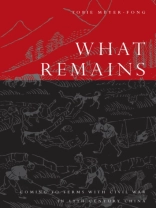The Taiping Rebellion was one of the costliest civil wars in human history. Many millions of people lost their lives. Yet while the Rebellion has been intensely studied by scholars in China and elsewhere, we still know little of how individuals coped with these cataclysmic events.
Drawing upon a rich array of primary sources, What Remains explores the issues that preoccupied Chinese and Western survivors. Individuals, families, and communities grappled with fundamental questions of loyalty and loss as they struggled to rebuild shattered cities, bury the dead, and make sense of the horrors that they had witnessed.
Driven by compelling accounts of raw emotion and deep injury, What Remains opens a window to a world described by survivors themselves. This book transforms our understanding of China’s 19th century and recontextualizes suffering and loss in China during the 20th century.
Table of Content
Contents and Abstracts
1
War
chapter abstract
This chapter introduces the main themes of the book and places it in historiographical context. The chapter argues that the Taiping Rebellion should be termed a civil war, and should be understood in relation to the questions and concerns of those who lived through it. It calls attention to the devastating human and material consequences of the Taiping War. The chapter identifies the reasons scholars in both the United States and China have tended to focus on other issues. Western scholars have emphasized the Taiping movement’s Christian orientation or roots in local religious practice or the biography of the movement’s founder. Chinese scholarship in general highlights place of the Taiping Heavenly Kingdom in the history of revolution in China.
2
Words
chapter abstract
This chapter uses the figure of Yu Zhi (1809-1874), a failed examination candidate and charismatic pro-Qing philanthropist, to explore the religiosity of pro-Qing Confucian orthodoxy. It thus adds to our understanding of the local elite activists who played a leading role in wartime defense and post-war reconstruction.
3
Marked Bodies
chapter abstract
This chapter examines how wartime identities were communicated and understood through tattoos, hairstyle, and clothing. It argues that the emphasis on (permanent) inscription of identities in fact bespoke profound anxiety about deception and betrayal, as wartime affinities were widely understood to be contingent and volatile.
4
Bones and Flesh
chapter abstract
This chapter asks what happened to the dead during the Taiping War. It examines the political meanings attached to corpses in Late Imperial China. The presence of unburied corpses represented a profound failure on the part of the dynasty and signaled a crisis of political legitimacy. Additionally, cannibalism—both rumored and real—indicated the total breakdown of society. Stories about coffins and corpses, lost and miraculously returned, heralded the virtue of the dead and their families. The act of burial conferred legitimacy upon those who did the burying: local officials and philanthropists.
5
Wood and Ink
chapter abstract
This chapter centers on efforts to commemorate the war dead in shrines and books. Using rituals and language provided by the dynasty, local communities sought to underscore their loyalty and obscure wartime ambivalence. This chapter deals with the construction of post-war myths about wartime loyalty and dynastic victory. It also examines the ways in which groups empowered by the war made use of commemoration to further their causes in the post-war.
6
Loss
chapter abstract
This chapter highlights one man’s efforts to honor his deceased mother in writing. As a boy of eight, Zhang Guanglie witnessed his mother’s murder during the Taiping occupation of Hangzhou in 1861. In his ‘Record of 1861, ‘ he both uses and challenges the conventions used in official commemoration for the war dead. His idiosyncratic and fragmentary book documents his deeply personal search for consolation. The chapter also deals with the role of publishing and newspapers as a medium for the formation of new types of post-war community.
7
Endings
chapter abstract
This short chapter considers the ways in which war transformed the lives of survivors. It looks at ghost stories, memoirs, and Buddhist rites as places where emotion and memory lingered, unsettled, giving lie to the easy narrative of dynastic victory and communal closure.
About the author
Tobie Meyer-Fong is Associate Professor and Director of Graduate Studies in the History Department at Johns Hopkins University. She is the author ofBuilding Culture in Early Qing Yangzhou (Stanford, 2003) and co-editor of the journal
Late Imperial China.












